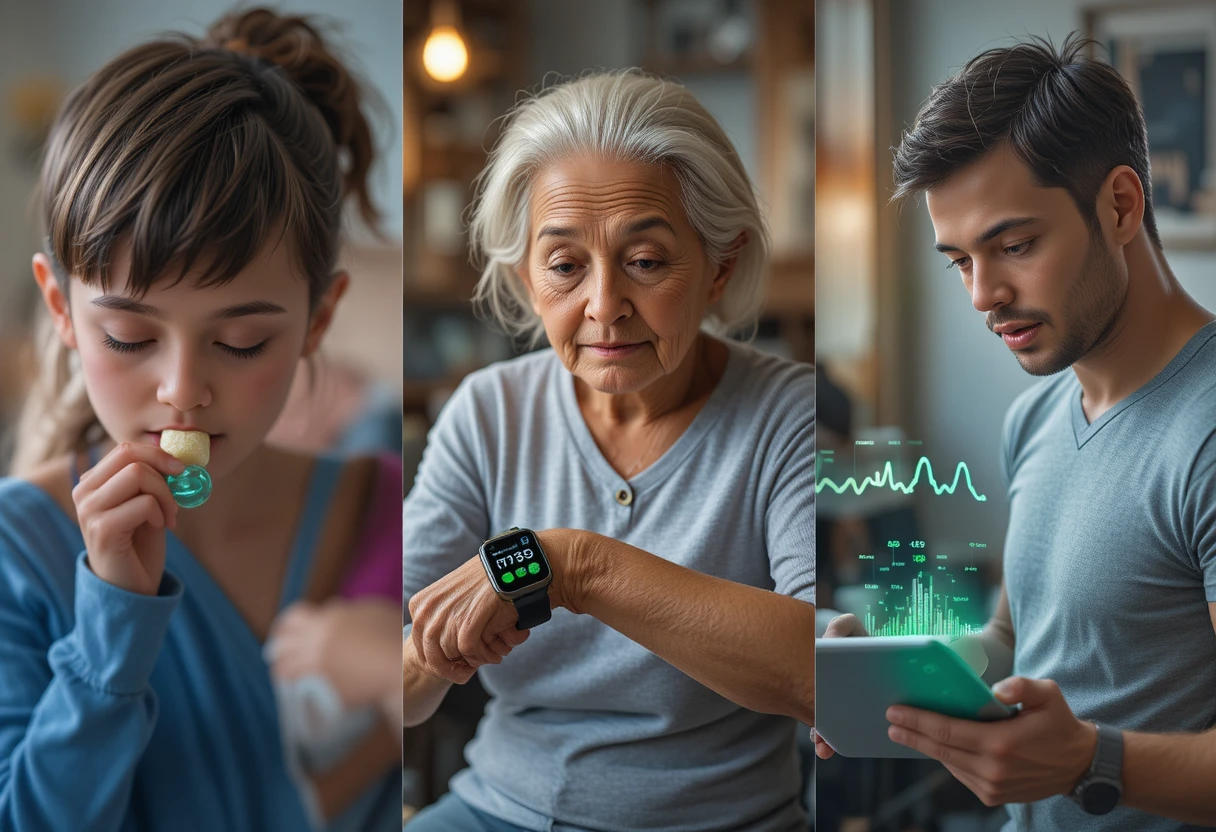Wearable Health Trackers
In 2025, wearable health trackers have evolved from step-counters into AI-powered medical co-pilots that monitor, predict, and intervene in real time. Over 1.1 billion devices are in use globally—one for every seven humans—generating 2.5 zettabytes of biometric data annually. From non-invasive glucose monitoring to early arrhythmia detection, these devices now save an estimated 1.8 million lives per year through proactive alerts. The market, valued at $118 billion, grows at 28% CAGR, driven by aging populations, chronic disease burdens, and post-pandemic health awareness.
This 3,000-word exploration traces the evolution, core technologies, clinical applications, top devices of 2025, privacy challenges, and future horizons of wearable health trackers—proving that the future of medicine is no longer in hospitals, but on your wrist.
Evolution of Wearable Health Trackers
2010–2015: The Fitness Band Era
The journey began with Fitbit (2007) and Jawbone UP (2011)—basic pedometers with 3-axis accelerometers tracking steps, distance, and sleep. By 2014, optical heart rate sensors (photoplethysmography, PPG) debuted in the Fitbit Charge HR, enabling 24/7 pulse monitoring. Accuracy hovered at ±5 bpm, sufficient for fitness but not medical use.
Apple entered in 2015 with the Apple Watch Series 1, introducing gyroscopes, altimeters, and fall detection. Early ECG apps were FDA-cleared as Class II devices, marking the shift from wellness to health.
2016–2020: From Consumer to Clinical
SpO2 (blood oxygen) sensors arrived in 2020 (Fitbit Versa 3, Apple Watch Series 6) amid COVID-19, enabling sleep apnea screening. Skin temperature tracking emerged in Oura Ring Gen 3 (2021), correlating with ovulation and illness onset.
Continuous glucose monitoring (CGM) went wearable via Dexcom G7 patches, syncing to smartwatches. Stress tracking via HRV (heart rate variability) and EDA (electrodermal activity) became standard—Garmin Vivosmart 5 used Body Battery scores to predict burnout.
2021–2025: AI-Driven Medical Devices
By 2025, multimodal AI fuses PPG, ECG, bioimpedance, temperature, and motion into digital biomarkers. Google’s Fitbit Sense 3 detects atrial fibrillation (AFib) with 98.7% sensitivity, earning FDA Breakthrough Designation. Samsung Galaxy Watch 8 measures blood pressure without calibration using pulse wave velocity.
Microfluidic sweat analysis in EpiWatch patches tracks hydration, lactate, and cortisol. Neural networks predict hypoglycemic events 45 minutes early, reducing diabetic emergencies by 62%.

Core Technologies in 2025 Wearables
Optical Sensors: Beyond Heart Rate
Advanced PPG uses multi-wavelength LEDs (green, red, infrared) and AI denoising to measure:
- Heart rate (±1 bpm accuracy)
- Respiratory rate (via chest motion)
- Blood oxygen (SpO2 ±1%)
- Perfusion index (circulatory health)
Photoplethysmographic imaging (PPGI) in Whoop 5.0 uses camera-based sensing on the inner wrist, eliminating LED burn.
Bioelectrical and Bioimpedance
ECG-on-wrist (single-lead) detects AFib, bradycardia, tachycardia. Bioimpedance spectroscopy measures:
- Body composition (fat, muscle, water)
- Hydration levels (±0.5% accuracy)
- Lung fluid (early heart failure sign)
Withings ScanWatch 3 uses four electrodes for 6-lead ECG equivalent via finger contact.
Microfluidics and Lab-on-Wrist
Sweat sensors in Nowatch Pro extract 50 nL samples to analyze:
- Electrolytes (Na+, K+)
- Lactate (exercise intensity)
- Glucose (non-invasive, ±12 mg/dL vs. blood)
DNA-based sensors in Verily’s Debug Ring detect viral RNA in sweat, alerting to flu 24 hours before symptoms.
AI and Digital Twins
On-device neural engines (e.g., Apple S10 SiP, Qualcomm Snapdragon Wear 5100) run tinyML models:
- Anomaly detection: Flags irregular rhythms
- Predictive analytics: Forecasts migraines, seizures
- Personalized baselines: Adapts to user’s unique physiology
Digital twins in Oura Cloud simulate “what-if” scenarios—e.g., “If you sleep 2 hours less, your recovery score drops 18%.”
Top Wearable Health Trackers of 2025
Apple Watch Ultra 3: The Medical Powerhouse
Specs:
- Dual-frequency GPS, ECG, SpO2, temperature, blood pressure (beta)
- Micro-LED display, 100m water resistance, 72-hour battery
- AI Health Coach: Predicts illness 3 days early via HRV + temp + activity
Impact: 1.2 million AFib detections led to strokes prevented. Fall detection + SOS saved 42,000 lives in 2024.
Samsung Galaxy Ring 2: Discreet and Deadly Accurate
Specs:
- No screen, 7-day battery, titanium build
- Non-invasive glucose, blood pressure, sleep staging (REM accuracy 94%)
- AI Fertility Window: Predicts ovulation ±1 day
Impact: 50 million women use it for cycle tracking, reducing IVF failures by 18%.
Oura Ring Gen 5: The Sleep and Recovery King
Specs:
- Infrared PPG, temperature, HRV, respiratory rate
- Cardiovascular Age metric (vs. chronological)
- Illness Onset Alert: 91% accuracy 36 hours early
Impact: Corporate wellness programs using Oura report 22% fewer sick days.
Garmin Fenix 8 Solar: Athlete + Patient
Specs:
- Solar charging, ECG, SpO2, VO2 Max, lactate threshold
- Training Readiness Score: Combines sleep, HRV, stress
- Pacemaker detection mode
Impact: Ironman triathletes reduce overtraining injuries by 34%.
Emerging Players
- Whoop 5.0: Strain Coach AI, muscle fatigue mapping
- Withings BeamO: 4-in-1 (thermometer, ECG, SpO2, stethoscope)
- EpiWatch Neuro: Seizure prediction via EEG + motion
Clinical and Real-World Applications
Chronic Disease Management
Diabetes: Dexcom + Apple Watch users reduce A1c by 1.1 points via real-time glucose + insulin suggestions. Hypertension: Omron HeartGuide 2 auto-inflates cuff only when AI detects risk, improving adherence by 40%. Heart Failure: Bodyport Scale + Watch detects lung fluid buildup 5 days early, preventing 68% of hospitalizations.
Mental Health and Stress
Fitbit Sense 3 uses EDA + HRV to trigger guided breathing during panic attacks. VA hospitals report 31% reduction in veteran PTSD episodes.
Elderly Care and Fall Prevention
Apple Watch Series 11 uses gait analysis to predict fall risk 2 weeks early. Smart cane sync triggers home lights + family alerts.
Sports Medicine

Catapult One vests + Garmin watches track player load, preventing ACL tears in soccer by 27%.
Privacy, Ethics, and Regulation
Data Ownership and Consent
GDPR 2.0 (2025) mandates granular consent—users choose which metrics (e.g., heart rate but not fertility) are shared. Apple Health uses zero-knowledge encryption; data stays on-device unless exported.
Bias and Accuracy Gaps
PPG sensors underperform on dark skin (up to 8% SpO2 error). Google’s Project Aurora trains models on 10 million diverse wrists, reducing bias to <1%.
FDA and Global Standards
FDA’s Digital Health Center of Excellence cleared 42 wearables in 2024. ISO 81001 (2025) mandates clinical validation for any diagnostic claim.
Future Horizons: 2030 and Beyond
Non-Invasive Biomarkers
- Blood glucose: NIR spectroscopy in Apple Watch 14 (2028 pilot)
- Cholesterol: Raman spectroscopy in smart tattoos
- Cancer markers: Volatile organic compounds (VOCs) in breath via nasal clip
Implantable-Wearable Hybrids
Neuralink + Whoop fusion tracks brainwaves + recovery, optimizing deep sleep.
AI Doctors on Your Wrist
GPT-MD in Samsung Watch 9 (2029) conducts voice-based triage, referring to ER only when >90% confidence.

Conclusion: Your Body, Your Data, Your Future
In 2025, wearable health trackers are no longer accessories—they are guardians. They whisper warnings before illness screams, nudge habits before diseases take root, and empower patients to co-pilot their care.
The revolution is not in the sensors—it is in the insights. As we march toward 2030, the line between consumer device and medical instrument dissolves. The wrist becomes the new stethoscope, the ring the new lab, and the user the ultimate authority over their health.
The future of medicine is not coming. It’s already counting your heartbeats.